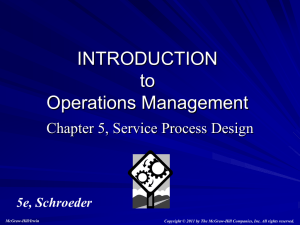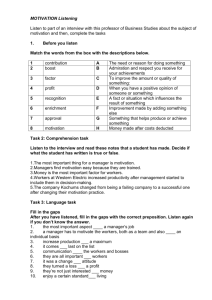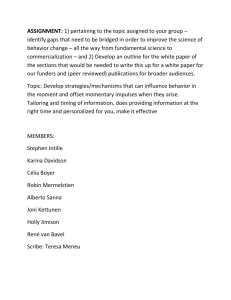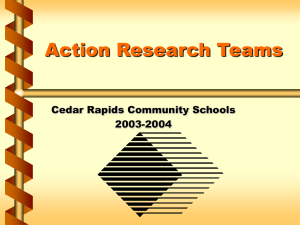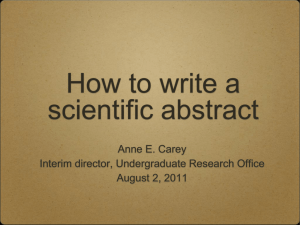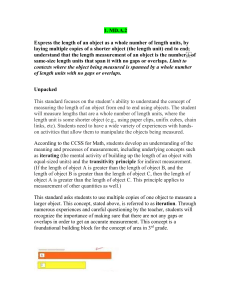LECTURE 10
advertisement
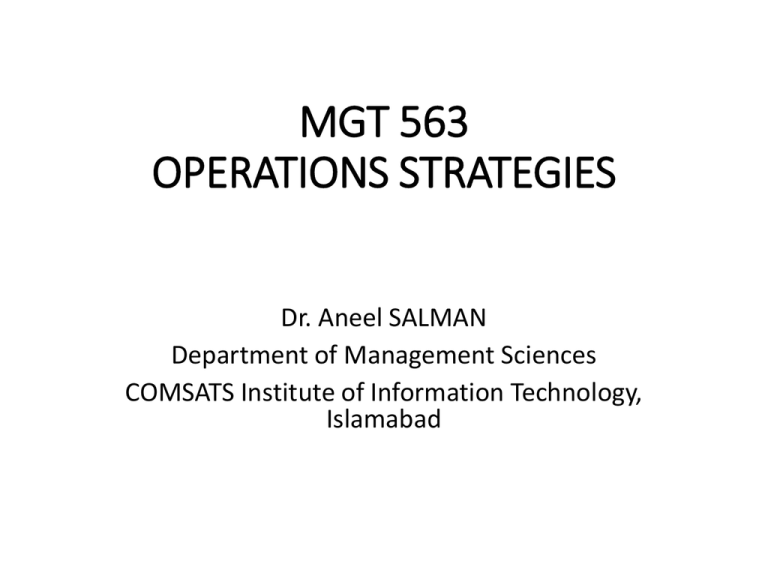
MGT 563 OPERATIONS STRATEGIES Dr. Aneel SALMAN Department of Management Sciences COMSATS Institute of Information Technology, Islamabad Recap Lecture 09 • Concept of Quality • Importance of Quality • Quality Gurus • The elements of TQM • European Foundation for Quality Management (EFQM) Model • Deming 14 Points Characteristics of Service • Intangible • No finished goods (cannot be “inventorized”) • Simultaneous production and consumption • Difficulty in defining and measuring quality and productivity • Perishability 3 The Shift to Services 4 Example: Services in Europe “The Service Sector accounts for about 70 percent of the European economy.” Source: Wall Street Journal, 4 March 2005, p. A13 Differences Between Manufacturing and Service (Table 5.1) 6 Comparison of Goods and Services (Figure 5.1) Services Goods 100% 75% 50% 25% 0% 25% 50% 75% 100% Automobile Installed carpeting Fast-food restaurant Gourmet restaurant Auto maintenance Haircut Consulting services 7 Service-Product Bundles The Service-Product Bundles has three parts: • tangible service (explicit service)—what the seller does for you. • psychological benefits (implicit service)—how you feel about it. • physical goods (facilitating goods & facilities) Production of Services versus Goods • Services are heterogeneous. • Customers served as first come, first served. • Labor is scheduled but may idle. • Location often near customers. • Result: service production tends to be _______ efficient than production of goods. How would you measure Efficiency or Inefficiency in services? Customer Contact Model • Potential inefficiency in services is a function of the amount of customer contact • Customer Contact • Definition of “contact”—interaction between service provider and the customer. • Why so? • Variability • Customer determines the time • Customer determines the order of service • Customer influences what happens during the service Service Matrix Customer Wants and Needs in the Service Package Operations Service System/Process Design Highly customized with unique process sequence. Many process pathways, jumbled flows, complex work with many exceptions Moderate number of process pathways. Flexible flows with some dominant paths, moderate work complexity. Limited number of process pathways. Line flows, low complexity work. Standardized with options; Using moderately repeatable sequence. Standardized with highly repeatable process sequence. Customer Routed Estate planning, personal trainer Co-Routed Stock brokerage, medical practice Provider Routed ATM Service Operations II (Service Design) 13 Technology in Service Design • Production-line approach to service • Services should be standardized and delivered in an efficient manner • Service facility designed to minimize mistakes • As much automation as possible • Service is provider routed with low customization Technology in Service Design (2nd view/approach) • Employees as the Center of Service Delivery • Technology should support, not replace workers • Train front-line workers as much as managers • Value investment in employees as much as in technology • Link compensation to performance at all levels Customer Contact Design • High contact (front room) services • Direct customer contact • Customer has more control of process • Low-contact (back room) services • Out of sight of customer • Provider has more control of process • Goal: move as much activity as possible to the back room—why? 16 Service Blueprint of Luxury Hotel 17 Customer Contact Variability Types of Variability induced by customers in service delivery: • • • • • arrival – when they arrive to consume a service request – what they ask for in the bundle capability – ability of customers to participate effort – willingness of customers to participate subjective preference – preferences of customers in how service is carried out Capacity Management Strategies Two key strategic issues • How can we manage the capacity? • How can we manage the demand? 19 Managing Capacity • Part-time workers • Shift scheduling • Co-production -- get the customer involved • Cross-trained workers • Information technologies • Focus factory -- reduce complexity 20 Managing Demand • Forecasting • Advertising • Reservation systems • Yield management Pricing Market segmentation 21 Customer Interface Strategies 1. Get the customer OUT of the process 2. Get the customer IN the process 3. Understand that your employees make the difference 22 Approaches to Service Design • Production-line • Customer as co-producer • Customer contact • Information empowerment 23 Service Operations III (Service Quality) 24 Service Quality Attributes • Search -- attributes customers can evaluate before purchase. • Experience -- attributes that customers can evaluate only during consumption. • Credence -- attributes difficult to evaluate even after consumption. 25 Service Quality Strategies 1. Understand the service gaps model 2. Design and implement a formal service recovery system 3. Institute service guaranties where appropriate 4. Conduct appropriate customer satisfaction surveys 5. People make the difference 26 Service Quality Strategies Understanding the gaps 27 Service Quality Strategies Understanding the gaps Experience - us Experience - others Intrinsic needs Expected Service Gap 1 Service Quality Gap Customer Provider Gap 2 Service Design Gap Perceived Service Service Delivered Gap 4 Production Gap Systems, Standards Gap 3 Process Design Gap Conceptual Model of the Customers’ Expectations Communications Gap 5 Perjury Gap 28 Service Quality Strategies 1. Understand the service gaps model 2. Design and implement a formal service recovery system 29 Service Quality Strategies 1. Understand the service gaps model 2. Design and implement a formal service recovery system • Listen • Apologize and show empathy • Ask the “recovery” question … “What can we do to satisfy you completely?” • Fix the problem quickly - prioritize customers and escalate if needed • Follow-up -- is the problem fixed … is the relationship fixed? 30 Service Quality Strategies 1. Understand the service gaps model 2. Design and implement a formal service recovery system 3. Institute service guaranties where appropriate 31 What is a Good Service Guarantee? • • Unconditional Meaningful • • Easy to understand and communicate • • • The payout fully covers customer dissatisfaction For customers For employees Painless to invoke
